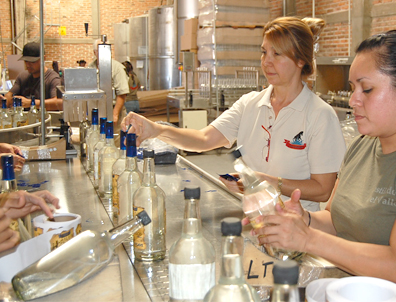
Visiting Tequila town ---
As a lover of quality tequila, I have wanted to visit Mexico’s tequila producing region for many years. I had read and heard things about the town of Tequila and the fields of agave. And I was familiar with many of the large and small distilleries and their history, but I still didn’t know what to expect from this famous destination. Would it be like California’s wine regions with hundreds of producers eagerly inviting crowds of tourists to their tasting rooms and factory tours? Would I be amazed at the variety of tequilas and how many new ones would I discover?
Meeting a friend just outside of Guadalajara – the business center of the tequila industry – we drove about forty kilometers through a rolling landscape of agave fields and volcanic rock. Arriving in the town of Tequila, it appeared like any other small Mexican town – quiet and slow-paced with a rural charm.
What makes Tequila different, though, are the many tequila tasting shops around town, most of which are operated by smaller distilleries that produce lower quality tequilas. I was surprised to not see any shops with the quality brands I know as a consumer in the U.S. I was more surprised by the small selection or complete absence of tequilas at the bars and restaurants in Tequila. Being in the capital of the tequila world, the irony was obvious, though I’ve seen the same lack of selection of quality tequilas (and overpriced) at bars and restaurants in many other parts of Mexico.
Fortunately, there were many good tequila distilleries to visit in and around the town. Even more fortunate was to connect with David Ruiz, a tequila industry expert and consultant who toured us to several historic distilleries. Ruiz is an American whose family’s roots are in the Tequila area. Now a full time resident of Mexico, Ruiz is a well known figure in the industry who leads tourists and business people on personalized tours of the distilleries and all points of interest related to tequila. See www.tequilatours.com.
As a consultant to tequila makers and marketers, Ruiz has an insider’s view of the industry and he reveals many surprising facts, such as the high level of American ownership of tequila companies. I was also surprised to learn that tequila makers add both color and flavor to their tequilas. “Tequila more than other spirits is a natural product that varies by the season and by the harvest so there are a lot of variants,” says Ruiz. “They’ll add some flavor or color to it to balance it out or some filtering so that it looks consistent to the consumer.” He also explained that ‘gold’ type tequilas are simply blanco tequilas with color added. But lovers of quality tequila don’t even look at bottom shelf products like gold or other ‘style’ products, though Ruiz is not a purist about what defines a quality tequila.
“If it’s not very good quality, the customer will tell you,” says Ruiz, referring to taste as the primary indicator. “There are some great mixto’s, blended tequilas, that are very smooth, but they’re not 100 percent (agave) and there some that are not great. And there are 100 percent tequilas that are lousy.” Ruiz believes that 100 percent tequila products are not always the best quality or taste. “It’s not true – it’s an appreciation of where it comes from,” he says.
Taste was not a subjective matter when Ruiz took us to Casa Maestri Destiladora del Valle de Tequila (www.casamaestri.com), which is operated by a Mexican-American family that has produced many tequila brands over three generations. Celia Villanueva de Maestri manages the distillery, whose products received eleven medal awards at the 2010 San Francisco World Spirits Competition. Villanueva de Maestri and her master distiller toured us through the distillery, which is currently being expanded to meet increased demand. Villanueva de Maestri speaks about some of the special methods they use to achieve their quality and we later see her working on the production line alongside her employees. Her complete involvement in every aspect of the business is an obvious factor in the company’s success. A closer look at her success and challenges will be the focus of a separate article by Vision Hispana.
My short visit to Tequila was only a brief education about an area that I plan to explore more in the future. I may return for the World International Tequila Conference http://tequilaconference.com in April. Education should be a lifelong pursuit.
